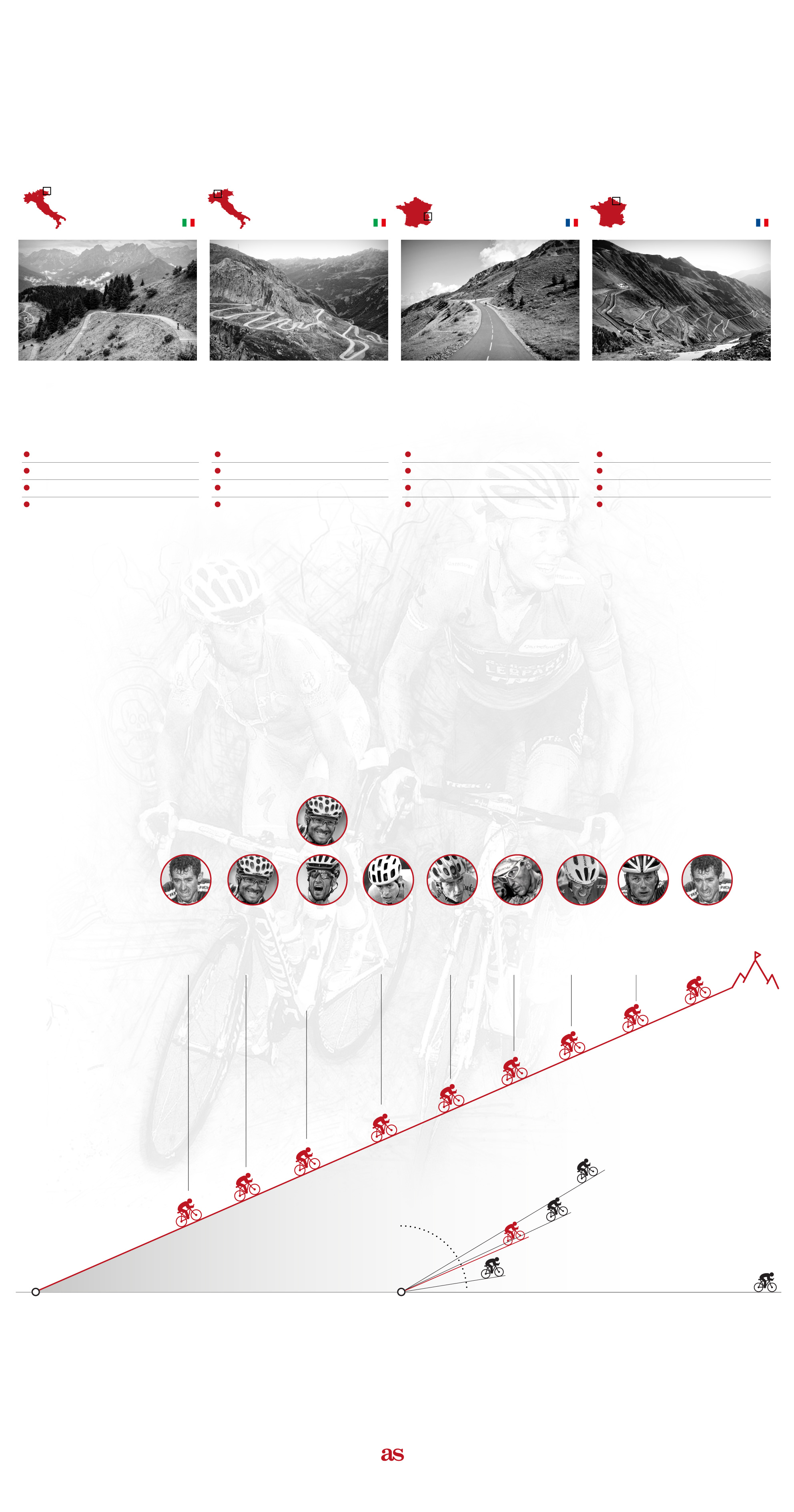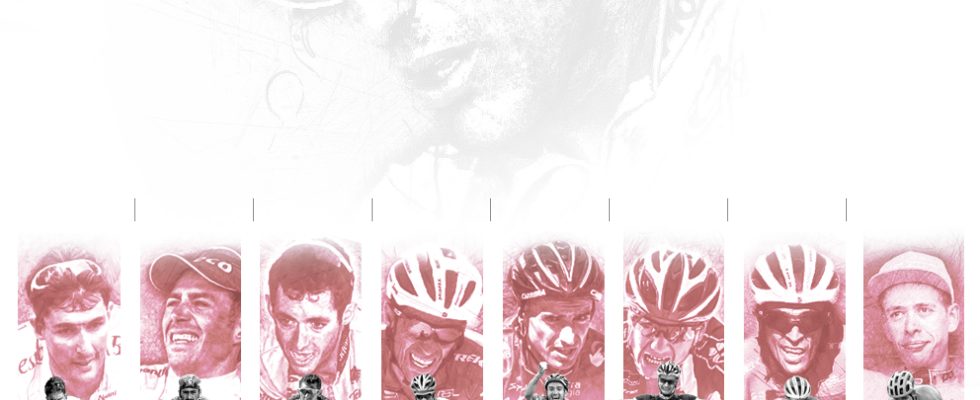It first appeared in the cycling world in 1999 and since then Angliru has become an iconic peak. That international showcase, with ‘Chava’ Jiménez as the first winnerr, promoted an ascent that takes cyclists to the limit of their capabilities, both due to the wild inclination and the tremendous hardness of its ramps. The port is made up of sections with their own identity. Les Cabanes (22%), Llagos (14.5%), Los Picones (20%), Cobayos (21.5%), La Cueña les Cabres (23.5%) and El Aviru (21.5%) They complete the climb, a total of 12.4 km at an average gradient of 9.8%.
It is not its altitude that is frightening, nor its
length. The harshness of Northern terror HE
settles in its wild inclination and the demand
of its ramps. Every climb to the top
Asturian becomes a phenomenon.
Its popularity refers to the most
pure mountain biking.
All the winners at the top of the colossus
The Angliru port gained international fame
when it was included as the end of the stage in the Vuelta
in 1999. This will be the ninth time he has been crowned
after ‘Chava’ did it for the first time
Jiménez in the remembered finale in which he starred together
to the Russian Pavel Tonkov.
*He was stripped of the victory for doping.
This is the queen stage of La Vuelta
Its route consists of 124.4 kilometers. Al Angliru
Two first-class ports precede it,
Colladiella and the Alto del Cordal, who has the last
kilometer and a half at 12% average and a descent
of the most dangerous.
Altitude: 10m
Distance: 0 km
Altitude: 1,558 m
Distance: 124.4 km
San Martin
of King Aurelius

It is not its altitude that is frightening, nor its
length. The harshness of Northern terror HE
settles in its wild inclination and the demand
of its ramps. Every climb to the top
Asturian becomes a phenomenon.
Its popularity refers to the most
pure mountain biking.
All the winners at the top of the colossus
The Angliru port gained international fame
when it was included as the end of the stage in the
Return in 1999. This will be the ninth time in
to be crowned after he did it for
‘Chava’ Jiménez for the first time in the remembered
finale in which he starred alongside the Russian Pavel Tonkov.
*He was stripped of the victory for doping.
This is the queen stage of La Vuelta
Its route consists of 124.4 kilometers. Al Angliru
Two first-class ports precede it,
Colladiella and the Alto del Cordal, who has the last
kilometer and a half at 12% average and a descent
of the most dangerous.
San Martin
of King Aurelius
It is an effort of more than 40 minutes… for those who finish in the first positions. It is the day marked in red for many runners, since, in just a couple of kilometers, the difference between runners can be minutes. It will be the ninth time that La Vuelta has crowned this peak. The previous one was in 2020, in a very different situation from the previous ones. It happened in the year of the pandemic, without fans in the ditches and with a shocking image with the runners ascending alone, with an audience absent due to health recommendations.

With the first five kilometers relatively
simple, the hardness begins once we reach the
Viapara area. From here they begin
sections succeed each other and upper slope curves
at 10% until reaching a turn that leads to the
terrible Cueña Les Cabres with its painful slope.
The climb covers 12.4 kilometers with
a difference of 1,218 meters and a slope
average of 9.8%.
The battle between
favorites for the general
usually occurs in
very hard ramps
finals
9.
8.
7.
6.
5.
4.
3.
2.
1.
Goal
Les Piedrusines
The Aviru
Les Cabres
Guinea pigs
The Picones
Llagos
Les Cabanes
Start
20.0%
21.5%
23.5%
21.5%
20.0%
14.5%
22.0%
9.1%
Last location
before the ascension.
The slope that opens the doors of suffering.
Once you cross the Viapará area,
The Curves of Les Cabanes are located
with a very hard slope of 22% that
runs 150 meters and that announces to the
cyclists the beginning of the agonizing ascent.
The center of the very difficult climb. After
get over Los Picones (with a 20% maximum)
and the Curva Los Cobayos, with a hairpin
of 21.5%, The route leads to the famous
Cueña de Les Cabres where you reach the
maximum slope: 23.5%.
The horror of Les Cabres was overcome, before
reach the final 400 meters with a slight
descent, cyclists will still have to face the
Aviru and Les Piedrusines ramps with
maximum slopes of 21.5% and 20%,
respectively.
The hardness of the Angliru prevents it from
steeper roads you can go by wheel, so
Each cyclist has to climb at his own pace. The distances
between first and second they have been decreasing
over the years.

With the first five kilometers relatively
simple, the hardness begins once we reach the
Viapara area. From here they begin
sections succeed each other and slope curves
superiors at 10% until reaching a turn that
leads to the terrible Cueña Les Cabres
with its painful slope.
The climb covers 12.4 kilometers with
a difference of 1,218 meters and a slope
average of 9.8%.
Last location
before the ascension.
9.
8.
7.
6.
5.
4.
3.
2.
1.
Goal
Les Piedrusines
The Aviru
Les Cabres
Guinea pigs
The Picones
Llagos
Les Cabanes
Start
20.0%
21.5%
23.5%
21.5%
20.0%
14.5%
22.0%
9.1%
The slope that opens the doors of suffering.
Once you cross the Viapará area, you will
find the Curves of Les Cabanes with a
very hard slope of 22% that runs 150 m
and that announces to the cyclists the beginning of the agony
ascension.
The center of the very difficult climb. After
get over Los Picones (with a maximum of 20%) and the
Los Cobayos Curve, with a range of 21.5%,
The route leads to the famous Cueña de
Les Cabres where the maximum of
earring: 23.5%.
Overcome the horror of Les Cabres, before arriving
at the final 400 meters with a slight descent, the
Cyclists will still have to face the ramps of the
Aviru and Les Piedrusines with maximum slopes
21.5% and 20%, respectively.
That will change in this 17th stage, which will also be crucial for the outcome of La Vuelta as it is held in the third week, four days before finishing in Madrid. The eight previous ascents left seven different winners. That is to say, one of them repeated: Alberto Contador (2008 and 2017), who also achieved his last victory here as a professional. The aforementioned José María Jiménez (1999), Gilberto Simoni (2000). Roberto Heras (2002), Juanjo Cobo (2011 and later disqualified for doping), Kenny Elissonde (2013) and Hugh Carthy (2020, the winners. These last two are present in this edition. Will there be a new runner who will inscribe his name on the wall at the top?

The Angliru, on par with the large ports
The legend of Angliru is similar to that of other
mythical climbs of the Tour de France or the Giro
from Italy. It is often compared to Zoncolan,
whose average slope is greater, but in the port
Asturian, greater differences have been seen between
the cyclists.
The climb from Ovaro has a
stretch of 6 kms. at an average of
14.5%. The port is considered
harder that is currently uploaded.
The mythical port that rises in the
heart of the Italian Alps has
always been considered as
one of the toughest in the world.
A slide of maximum hardness.
The final four kilometers are
terrible, with ramps of more than
twenty%.
It was first climbed in 1910 and
This year he was promoted in the Vuelta.
He has been crowned by the best
climbers of cycling history.
Extension:
Altitude:
Average slope:
Maximum slope:
9.8 km
1,210 m
12.5%
22.0%
Extension:
Altitude:
Average slope:
Maximum slope:
12.4km
1,307 m
10.5%
20.0%
Extension:
Altitude:
Average slope:
Maximum slope:
21.5 km
1,671 m
7.8%
24.0%
Extension:
Altitude:
Average slope:
Maximum slope:
19km
2,115 m
7.4%
10.9%
The fastest ascents to the Asturian summit
The ten most notable records have occurred
less than 45 minutes. This data yields a
average that defines the severity of the port:
It takes 3.5 minutes to complete a kilometer.
Roberto Heras and Alejandro Valverde have four
of the best times.
2013
Alexander
Valverde
Vincenzo
Nibali
Time:
41′ 55”
Speed:
18.32 km/h
Daytona Circuit (Nascar)
Corkscrew Curve (MotoGP)
Home of the port
La Vega-Riosa
Kilometer 112
340m
Slope comparison
The Asturian port is one of the toughest in the world and its maximum
slope, one of the largest that can be found in different
sports.
Source: lavuelta.com/Getty/Own elaboration.

The Angliru, on par with the great ports
The legend of Angliru is similar to that of other
mythical climbs of the Tour de France or the Giro
from Italy. It is often compared to Zoncolan,
whose average slope is greater, but in the port
Asturian, greater differences have been seen between
the cyclists.
The climb from Ovaro has a stretch of 6 km.
at an average of 14.5%. It is considered the
hardest port currently climbed.
Extension:
Altitude:
Average slope:
Maximum slope:
9.8 km
1,210 m
12.5%
22.0%
The mythical port that stands in the heart of the
Italian Alps has always been considered
as one of the toughest in the world.
Extension:
Altitude:
Average slope:
Maximum slope:
12.4km
1,307 m
10.5%
20.0%
A slide of maximum hardness. Debuted
this year on the Tour. The four kms. finals
They are terrible, with ramps of more than 20%.
Extension:
Altitude:
Average slope:
Maximum slope:
21.5 km
1,671 m
7.8%
24.0%
It was climbed for the first time in 1910 and this year it was
rose in the Vuelta. He has been crowned by
best climbers in the history of cycling.
Extension:
Altitude:
Average slope:
Maximum slope:
19km
2,115 m
7.4%
10.9%
Faster ascensions
The ten most notable records have occurred
less than 45 minutes. This data shows
an average that defines the severity of the port:
it takes 3.5 minutes to complete
One kilometer. Roberto Heras and Alejandro Valverde
They have four of the best times.
Source: lavuelta.com/Getty/Own elaboration.
